
Concept explainers
Consider the circuit in Figure P6.45. The transistor parameters are
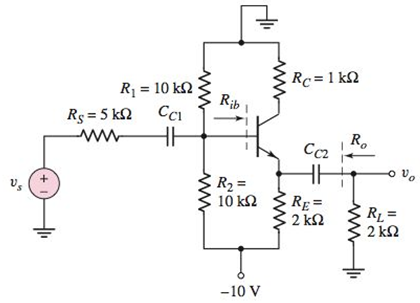
Figure P6.45
a.
The value of the ICQ and VCEQ .
Answer to Problem 6.45P
Explanation of Solution
Given:
The circuit is given as:
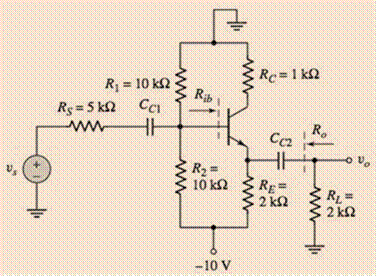
Calculation:
Let the BJT be the single node, then by applying Kirchhoff’s current law, the quiescent emitter current
In Common-Emitter mode:
The relation between the quiescent collector current is
For dc analysis,
All the capacitors act as an open circuit and all the ac sources act as short circuits.
DC analysis:
Redrawing the circuit by open circuit, the capacitors, and short circuit the ac sources.
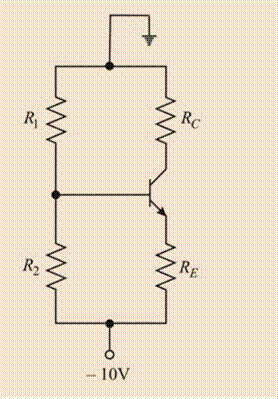
Evaluating the Thevenin resistance
Evaluating the Thevenin voltage,
Drawing the modified circuit:
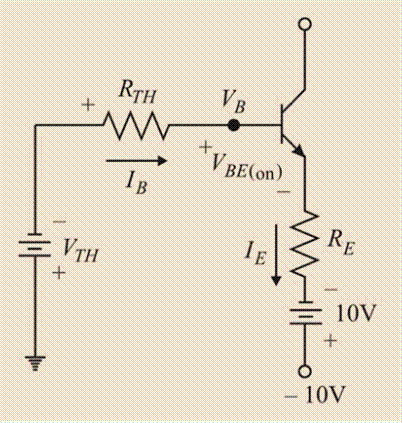
Applying the Kirchhoff s voltage law in the base-emitter loop,
Substituting
From equation (2):
Substituting
Therefore, the value of
From equation (1) and (2):
Substituting
Substitute
Drawing the modified circuit:
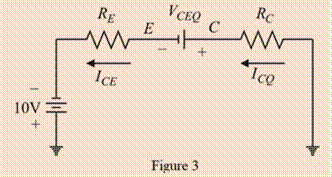
Applying Kirchhoff s voltage law to the loop,
Substituting
Therefore, the value of
b.
To plot: The dc and the ac load lines.
Explanation of Solution
Given:
The circuit is given as:
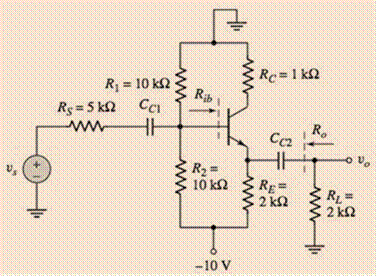
Calculation:
Applying Kirchhoff s voltage law around the collector-emitter loop in figure 1.
Substitute
Substitute
The required “Q” point co-ordinates are
Draw the DC load line:
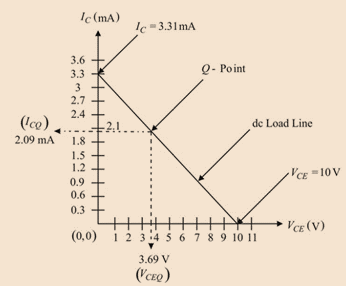
Drawing the AC equivalent circuit:
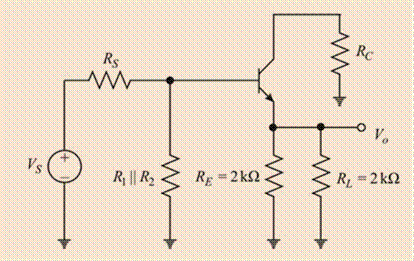
Evaluating the ac load
The expression for the ac load line:
Substitute
Substitute
Drawing the ac load line:
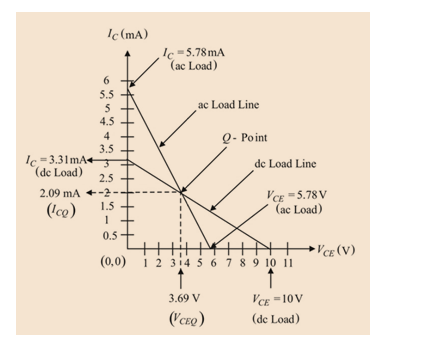
c.
The small signal voltage gain.
Answer to Problem 6.45P
The small signal voltage gain.
Explanation of Solution
Given:
The circuit is given as:
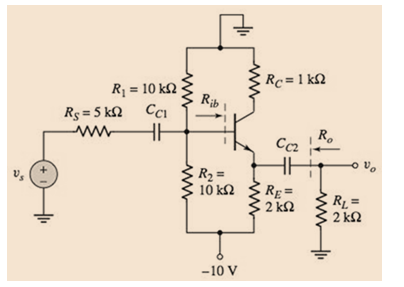
Drawing the small signal analysis of the circuit by short circuiting the dual dc sources and the capacitors:

Evaluating the diffusion resistance,
Evaluating the small signal transistor output resistance
Evaluating the input resistance
Calculate the input resistance
The small-signal voltage gain is,
d.
The output resistance.
Answer to Problem 6.45P
The output resistance is
Explanation of Solution
Given:
The circuit is given as
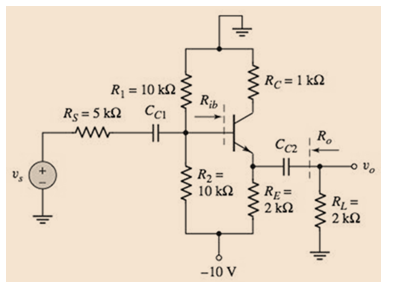
Calculation:
From equation 5,
Thus, the input resistance
Calculate the output resistance,
Therefore, the output resistance
Want to see more full solutions like this?
Chapter 6 Solutions
MICROELECT. CIRCUIT ANALYSIS&DESIGN (LL)
- P3. Given the following network, determine: ⚫ 3.a. Equivalent Y ⚫ 3.b. Equivalent A 2 R[2] 10 8 b 20 30 5arrow_forward[Electrical Circuits] P1. Using the mesh current method, calculate the magnitude and direction of: 1.a. I and I (mesh currents) 1.b. I10 (test current in R10 = 1082) 1.c. (Calculate the magnitude and signs of V10) 6[A] 12 [√] بي 10 38 20 4A] Iw -800arrow_forwardNeed handwritten solution do not use chatgptarrow_forward
- [07/01, 16:59] C P: Question: Calculate the following for 100Hz and 500Hz (express all answers in phasor form). Show all work. A) Xc and ZTB) VR1 and VC1 C) IT Handwritten Solution Pleasearrow_forward1. Sketch the root loci of a system with the following characteristic equation: s²+2s+2+K(s+2)=0 2. Sketch the root loci for the following loop transfer function: KG(s)H(s)=- K(s+1) s(s+2)(s²+2s+4)arrow_forward3. For the unity feedback system with forward path transfer function, G(s), below: G(s)= K(s² +8) (s+4)(s+5) Sketch the root locus and show the breakaway/break-in point(s) and jo-axis crossing. Determine the angle of arrival and K value at the breakaway/break- in point(s). Give your comment the system is stable or unstable.arrow_forward
- Find the step response of each of the transfer functions shown in Eqs. (4.62) through (4.64) and compare them. [Shown in the image]Book: Norman S. Nise - Control Systems Engineering, 6th EditionTopic: Chapter-4: Time Response, Example 4.8Solve the math with proper explanation. Please don't give AI response. Asking for a expert verified answer.arrow_forward2. With respect to the circuit shown in Figure 2 below V2 -R1 R2 R4 w R3 R5 Figure 2: DC Circuit 2 a. Using Ohm's and Kirchhoff's laws calculate the current flowing through R3 and so determine wattage rating of R3. b. Verify your results with simulations. Note: you must use the values for the components in Table 2. Table 2 V2 (Volts) R1 (KQ) R2 (KQ) R3 (KQ) R4 (KQ) R5 (KQ) 9 3.3 5 10 6 1 3.3arrow_forwardDon't use ai to answer i will report your answerarrow_forward
- Don't use ai to answer I will report you answerarrow_forwardcircuit value of i1 and i2arrow_forwardIn the circuit shown in the figure, the switch opens at time t = 0. For t≥ 0 use I(t) and V₁(t) or Find Vc(t) and lc(t). D to icht) w 43 ViLC+) + vc(+) 5. F + 1252 18 A 3) 2H2VLCH 8 V 4л warrow_forward
 Introductory Circuit Analysis (13th Edition)Electrical EngineeringISBN:9780133923605Author:Robert L. BoylestadPublisher:PEARSON
Introductory Circuit Analysis (13th Edition)Electrical EngineeringISBN:9780133923605Author:Robert L. BoylestadPublisher:PEARSON Delmar's Standard Textbook Of ElectricityElectrical EngineeringISBN:9781337900348Author:Stephen L. HermanPublisher:Cengage Learning
Delmar's Standard Textbook Of ElectricityElectrical EngineeringISBN:9781337900348Author:Stephen L. HermanPublisher:Cengage Learning Programmable Logic ControllersElectrical EngineeringISBN:9780073373843Author:Frank D. PetruzellaPublisher:McGraw-Hill Education
Programmable Logic ControllersElectrical EngineeringISBN:9780073373843Author:Frank D. PetruzellaPublisher:McGraw-Hill Education Fundamentals of Electric CircuitsElectrical EngineeringISBN:9780078028229Author:Charles K Alexander, Matthew SadikuPublisher:McGraw-Hill Education
Fundamentals of Electric CircuitsElectrical EngineeringISBN:9780078028229Author:Charles K Alexander, Matthew SadikuPublisher:McGraw-Hill Education Electric Circuits. (11th Edition)Electrical EngineeringISBN:9780134746968Author:James W. Nilsson, Susan RiedelPublisher:PEARSON
Electric Circuits. (11th Edition)Electrical EngineeringISBN:9780134746968Author:James W. Nilsson, Susan RiedelPublisher:PEARSON Engineering ElectromagneticsElectrical EngineeringISBN:9780078028151Author:Hayt, William H. (william Hart), Jr, BUCK, John A.Publisher:Mcgraw-hill Education,
Engineering ElectromagneticsElectrical EngineeringISBN:9780078028151Author:Hayt, William H. (william Hart), Jr, BUCK, John A.Publisher:Mcgraw-hill Education,





